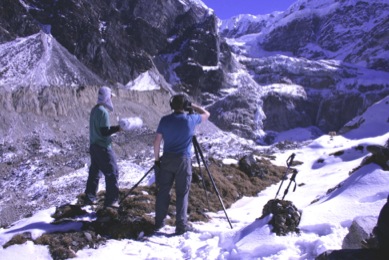An issue close to my heart
30/01/14 14:41
If you have seen my video on changes in glaciation in the Himalayas you will gather that it is an issue close to my heart.
One of the things that attracted me to Joseph Hooker and his relationship with Charles Darwin was that they followed the facts even though these may have been at odds with their personal beliefs. That is what I call “Good Science” and is the underlying theme of my project. I can think of no greater scientific controversy since Darwin, Hooker and others faced off with the Church in 1860 than that currently facing climate change scientists.
Recession of glaciers in the Himalayas and elsewhere is a very topical component of the climate change debate. For example, Himalayan glacial waters are essential to the existence of more than a billion people.
My opinions are based on my own observations accompanied by examination of the drawings of Joseph Hooker as described in two of my short videos. From looking at the glacial tubes - the depression bounded by the two lateral and terminal moraines - of the glaciers on the western and eastern sides of Mt Kangchenjunga, it is not clear to me whether recession is occurring. This could be due to a possible increase in the severity of the southeast monsoon as more violent storms come up from the Bay of Bengal because of warmer sea temperatures and dump their precipitation onto the nearby Kangchenjunga massif. Such storms can result in increased flash flooding and erosion even if the total annual precipitation is constant.
On the other hand once you travel into the rain shadow of the Kangchenjunga group of mountains it is clear that severe recession has occurred. This is evident from the empty glacial tubes in the Kanglachen valley and around Nango Mountain as well as the difference between the paintings of Joseph Hooker in 1848 and what one sees today. It isn’t clear whether this recession is fairly recent or spread evenly over the past 165 years. From personal observations in Peru and the Canadian Rockies it is evident that recession of glaciers is quite dramatic in those areas. In addition almost every week we hear about the loss of sea ice in the Arctic and glacial coverage in Greenland. In 1977-78 I visited Cape Adare and the Balleny islands in the Antarctic. These places also now appear to have less sea and land ice.

Nango Glacier now with empty glacial tube on left
In producing my project I have interviewed many prominent botanists and scientists around the world and have found without exception a great concern about climate change. I find it incomprehensible that many politicians appear not to share this concern.
As an Australian I am particularly worried. Australia is a country with a great and growing carbon footprint and the political debate and action on climate change here is almost nonexistent and is being increasingly gagged through the loss of funding to scientists working in this field. At the same time we are rushing to build enormous coalmines. Yet Australia is likely to be one of the countries most affected by a change in global temperature.
I wonder how those in power in my country do not appear to make the connection between the future of their children and grandchildren and their own lack of action.
Next week a lighter topic: How my first Joseph Hooker expedition began.
One of the things that attracted me to Joseph Hooker and his relationship with Charles Darwin was that they followed the facts even though these may have been at odds with their personal beliefs. That is what I call “Good Science” and is the underlying theme of my project. I can think of no greater scientific controversy since Darwin, Hooker and others faced off with the Church in 1860 than that currently facing climate change scientists.
Recession of glaciers in the Himalayas and elsewhere is a very topical component of the climate change debate. For example, Himalayan glacial waters are essential to the existence of more than a billion people.
My opinions are based on my own observations accompanied by examination of the drawings of Joseph Hooker as described in two of my short videos. From looking at the glacial tubes - the depression bounded by the two lateral and terminal moraines - of the glaciers on the western and eastern sides of Mt Kangchenjunga, it is not clear to me whether recession is occurring. This could be due to a possible increase in the severity of the southeast monsoon as more violent storms come up from the Bay of Bengal because of warmer sea temperatures and dump their precipitation onto the nearby Kangchenjunga massif. Such storms can result in increased flash flooding and erosion even if the total annual precipitation is constant.
On the other hand once you travel into the rain shadow of the Kangchenjunga group of mountains it is clear that severe recession has occurred. This is evident from the empty glacial tubes in the Kanglachen valley and around Nango Mountain as well as the difference between the paintings of Joseph Hooker in 1848 and what one sees today. It isn’t clear whether this recession is fairly recent or spread evenly over the past 165 years. From personal observations in Peru and the Canadian Rockies it is evident that recession of glaciers is quite dramatic in those areas. In addition almost every week we hear about the loss of sea ice in the Arctic and glacial coverage in Greenland. In 1977-78 I visited Cape Adare and the Balleny islands in the Antarctic. These places also now appear to have less sea and land ice.

Nango Glacier now with empty glacial tube on left
In producing my project I have interviewed many prominent botanists and scientists around the world and have found without exception a great concern about climate change. I find it incomprehensible that many politicians appear not to share this concern.
As an Australian I am particularly worried. Australia is a country with a great and growing carbon footprint and the political debate and action on climate change here is almost nonexistent and is being increasingly gagged through the loss of funding to scientists working in this field. At the same time we are rushing to build enormous coalmines. Yet Australia is likely to be one of the countries most affected by a change in global temperature.
I wonder how those in power in my country do not appear to make the connection between the future of their children and grandchildren and their own lack of action.
Next week a lighter topic: How my first Joseph Hooker expedition began.


